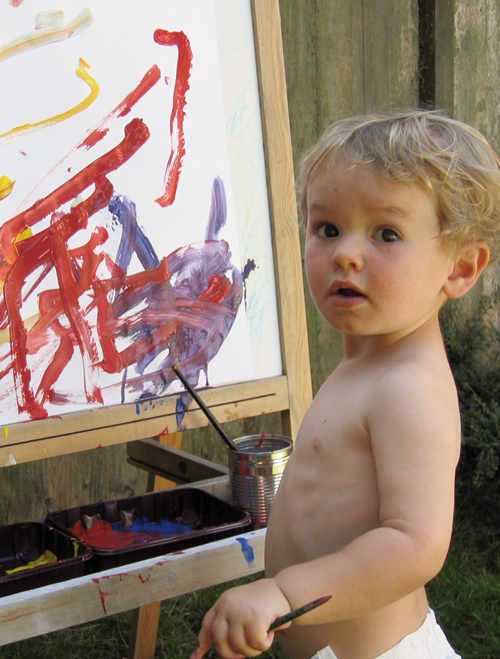Whatever their age, encourage children to make meaningful choices about their creative work, says Robert Watts…
The photograph below shows my son Joe, taken when he was nearly two. At the time it was simply a snapshot, a record of a pleasant afternoon spent in the garden, splashing around with paint.

On reflection, I think it raises some interesting questions for teachers regarding planning, structuring and presenting creative activities for young children.
But before we explore these questions, try a little task. Look at the photograph, pick up a pen and make a list of decisions that you can see.
The activity Joe is engaged with is nothing complicated – it’s one seen every day in Foundation Stage settings across the country.
However, I’m confident that you’ll have compiled a fairly substantial list of decisions, ranging from the colours of the paints in the palettes to the scale of the brushstrokes on the paper.
We’ll examine these decisions more closely. However, before we do, check your list carefully: who was responsible for each of the decisions you identified? Were they all made by Joe?
Or were some of the decisions made by the invisible presence in the photograph – the adult responsible for planning, monitoring and recording the activity?
It took me some time to realise that, when I arranged Joe’s painting session, I took several decisions that I thought would make the experience easier and more enjoyable for him. However, these may actually have restricted the range of possible outcomes of the activity.
As a lecturer in education, I spend a lot of time in schools supporting student teachers, suggesting ways in which they might encourage children’s capacities for individuality and self-expression. Yet, here I was, in the garden on a summer’s afternoon, nonchalantly narrowing down Joe’s options for his masterpiece.
In this article I’d like to explore some ideas about the importance of encouraging children to make meaningful choices about their creative work. We will:
Making meaningful choices is a key part of the process of creating artworks. Even artworks that might appear to be quite random in nature often have, on close inspection, a structure that unites their various elements.
Jackson Pollock’s abstract paintings, for example, made by dripping paint directly onto canvases stretched across his studio floor, have a strong underlying composition. This makes them more accessible to the viewer.
Now, it’s possible that the three-and-four-year-olds in your setting may not be au fait with the subtleties of abstract expressionism. But rest assured that many of them wouldn’t hesitate to experiment with paint in ways that Pollock would have admired.
But what kinds of decisions might they make in the process? Let’s look closely at the photograph of Joe painting, and at the visible evidence of decisions made both by him and, firstly, by his teacher – me.
The decisions I made relate to the aims of the activity, together with the environment and resources allocated towards it.
My aims were for Joe to begin to develop his confidence in using brushes to mix and apply paint to paper and to work on a relatively large scale.
Obviously, articulating these aims to a two-year-old wasn’t really an option. So my hope was that I would facilitate the creative experience for him by making the relevant preparations.
Taking advantage of the warm weather, I decided to set up an easel outdoors. This enabled Joe to work on a scale that would be difficult to manage indoors.
I decided to clip a piece of A2 paper to the top of the easel, arranging it vertically so that it was taller than it was wide.
I squeezed out some ready-mixed paint into two palettes, taking care to put red, blue and white paint in one and yellow, red and white in the other. (This was to hopefully delay the inevitable process of all the colours merging to make brown.)
I also decided to provide him with two brushes, one large, one small, and a pot of clean water. I then stepped back and let nature, in the form of Joe, take its course. It was now up to him to make a few decisions of his own.
The decisions Joe made during the activity relate to several specific elements of art and design:
Each of these decisions, however, was influenced in some way by the decisions I had already made for him before he began the activity.
From the photograph we can see that the composition of the painting centres on an emerging cluster of overlapping brushstrokes of red, blue and purple.
Why has Joe decided to concentrate on this part of the paper? Was it aesthetic judgement on his part? Or was it that he simply could not reach any higher up the paper?
There are a few isolated brushstrokes towards the top of the page. However, notice how pale in tone these are in comparison with those further down the paper. It was pinned so high that Joe could barely reach the upper half of it
At the point at which the photograph was taken, Joe’s composition of brushstrokes looks rather effective. There’s a nice balance between the various marks and between the different tones and colours.
On reflection, this was probably what prompted me to take the photograph at that moment – another decision on my part. I suspected that, if Joe continued in much the same vein, he would sooner or later obliterate the work he had made so far, as young children often do.
Making the big decision – that an artwork is finished – is very difficult for children. Often, they simply want to keep on going. And while, as adults, we treasure the products of children’s endeavours, children themselves are more likely to value the process by which they are made.
Some of Joe’s actions during the making of his painting can be regarded as meaningful choices, while others are better described as discoveries.
Every creative activity offers the potential for children to discover something new about the processes and the materials they are using.
In our efforts to ensure that each child has opportunities to engage with new creative experiences in the classroom, we can often speed them through this process. We forget to offer them time to make decisions.
Through making meaningful choices they will make new discoveries about the processes and materials they are using. And unless we highlight these opportunities, they can easily go unnoticed.
It need not be a case of allowing children free rein over the contents of the art cupboard. Simply start by providing children with an idea or stimulus – and then see where they want to take it.
The important thing is for teachers to be aware of the choices they are making in planning and presenting creative activities and for children to develop their awareness of their capacity for making their own meaningful choices.
Try planning a creative activity with some idea of what you want the children to do – but nothing too specific.
Begin by resourcing the lesson and offering a choice of materials. Then let children experiment and play with what you’ve provided.
Take some time to observe their investigations then decide when to intervene. Ask children to reflect upon the effects of the decisions they have already made.
Then prompt them to consider further decisions. Two simple questions, “What next?” and “What if?”, can prompt children to discover interesting and individual outcomes.
Robert Watts is a senior lecturer in Art and Design Education at Roehampton University, London. He is the co-author of Teaching Art and Design 3–11.
Rhythm games – Encouraging literacy through music
Editors picks

Neurological development – How do children really learn?
Editors picks
